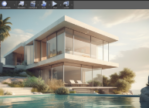Transform Your Interior Space with Rendering

Whether you’re an interior designer, architect, or homeowner, the importance of visualizing your space before committing to a design cannot be overstated. With advancements in technology, 3D rendering has become an increasingly popular tool for achieving this goal. In this article, we’ll explore the benefits of 3D rendering for interior design and how it can help transform your space.
What is 3D Rendering?
3D rendering is the process of creating a 3D image from a 2D model using computer software. It is commonly used in architecture, interior design, product design, and video games. 3D rendering allows designers and architects to create realistic and detailed visualizations of their designs, making it easier to communicate ideas with clients, contractors, and other stakeholders.
Benefits of 3D Rendering in Interior Design
Realistic visualization
One of the main benefits of 3D rendering is that it allows designers to create photorealistic images of their designs. This is particularly useful in interior design, where clients need to visualize how a space will look before it is built. 3D rendering can help designers create accurate representations of their designs, allowing clients to see how the space will look and feel.
Flexibility
With 3D rendering, it’s easy to make changes to a design. Designers can quickly make adjustments to a model and see the results in real-time. This is particularly useful when working with clients who may want to make changes to a design. It’s also useful for designers who want to experiment with different layouts, materials, and colors.
Cost-effective
3D rendering can help reduce costs associated with traditional design methods. With 3D rendering, designers can create virtual models of a space, reducing the need for physical models. This can help save on materials and labor costs. Additionally, 3D rendering can help identify design issues early on, reducing the need for costly revisions later in the design process.
Improved communication
3D rendering can help improve communication between designers, clients, and contractors. With photorealistic images, clients can easily understand how a space will look and feel. Contractors can also use 3D models to better understand the design intent and ensure that construction is executed according to the design.
How 3D Rendering Works in Interior Design
To create a 3D rendering, designers start with a 2D model of the space. This can be created using computer-aided design (CAD) software or by hand. Once the 2D model is complete, designers use 3D rendering software to create a photorealistic image of the space.
The process of creating a 3D rendering typically involves the following steps:
Modeling
3D rendering can help reduce costs associated with traditional design methods. With 3D rendering, designers can create virtual models of a space, reducing the need for physical models. This can help save on materials and labor costs. Additionally, 3D rendering can help identify design issues early on, reducing the need for costly revisions later in the design process.
Texturing
Once the 3D model is complete, designers can add textures to the surfaces of the space. This can include materials like wood, stone, and metal. Designers can also add colors and patterns to the surfaces to create a more realistic image.
Lighting
Lighting is an important part of creating a photorealistic image. Designers can add virtual lights to the 3D model to simulate natural and artificial lighting conditions. This can help create a more realistic image of how the space will look and feel
Rendering
Once the model is complete, designers can use rendering software to create the final image. This can take several hours or even days, depending on the complexity of the model and the level of detail required. The final image is a high-quality, photorealistic representation of space.
Types of 3D Rendering in Interior Design
There are two main types of 3D rendering used in interior design: still images and animations.
Still images are static images that show a single view of space. These images are useful for presenting design concepts to clients, as well as for marketing and advertising purposes.
Animations, on the other hand, are dynamic and can show different views of space from different angles. They can also show how space will look at different times of day or under different lighting conditions. Animations are useful for creating walkthroughs of the space and for showing clients how the space will look and feel.
How to Use 3D Rendering in Interior Design
There are several ways to use 3D rendering in interior design. Here are some examples:
Presenting design concepts
3D rendering can be used to present design concepts to clients. Designers can create photorealistic images of the space that show the layout, materials, and lighting. This can help clients visualize the space and provide feedback on the design.
Marketing and advertising
3D rendering can also be used for marketing and advertising purposes. Designers can create high-quality images of the space that can be used in brochures, websites, and other marketing materials. These images can help attract potential buyers and showcase the features of the space.
Virtual walkthroughs
3D rendering can also be used to create virtual walkthroughs of space. This allows clients to experience the space as if they were there in person. Virtual walkthroughs can be used to showcase the space to potential buyers or to help clients make design decisions.
Design revisions
Finally, 3D rendering can be used to make design revisions. Designers can quickly make changes to the 3D model and see the results in real-time. This allows for a faster and more efficient design process.
Conclusion
3D rendering has become an increasingly popular tool in interior design. It allows designers to create photorealistic images of their designs, making it easier to communicate ideas with clients, contractors, and other stakeholders. 3D rendering is also flexible, cost-effective, and can help improve communication between designers and clients. Whether you’re an interior designer, architect, or homeowner, 3D rendering can help transform your space and bring your design ideas to life.



